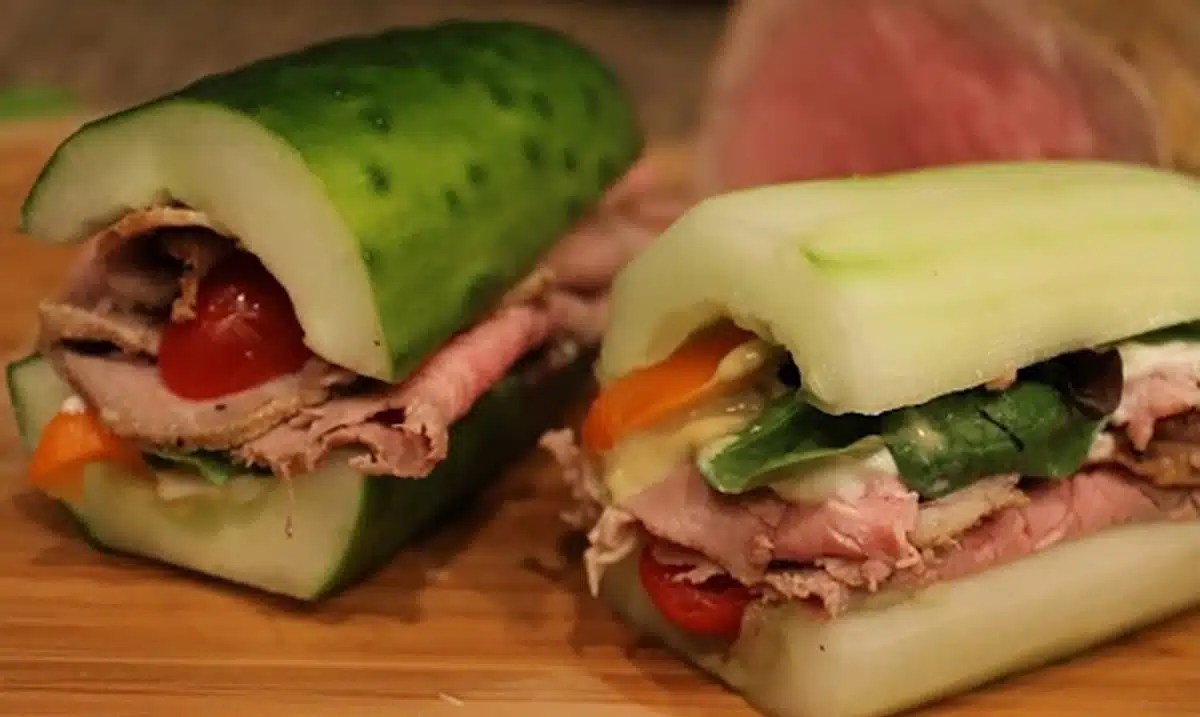Forget the bread! Embark on a culinary adventure exploring the vibrant world of paleo sandwiches, where creativity reigns supreme. This isn’t about restriction; it’s about unlocking a universe of flavor and texture, crafting satisfying and nutritious meals without relying on traditional bread. We’ll delve into ingenious bread alternatives, from nutty almond flour creations to vibrant vegetable wraps, showcasing the diverse possibilities available to the paleo enthusiast. Prepare to discover mouthwatering combinations of savory meats, poultry, and seafood, complemented by fresh, flavorful vegetables and homemade sauces that elevate each bite to a new level of deliciousness.
Through detailed recipes and step-by-step guides, you’ll learn how to construct visually stunning and structurally sound paleo sandwiches that are as delightful to look at as they are to eat. We’ll explore the nutritional benefits of various ingredients, compare different cooking methods, and provide expert tips for balancing flavors and textures. Whether you’re a seasoned paleo chef or a curious beginner, this guide will empower you to create paleo sandwiches that are both satisfying and surprisingly easy to make.
Savory Paleo Sandwich Fillings

The heart of any satisfying paleo sandwich lies in its filling. Choosing the right combination of flavors and textures is key to creating a truly memorable meal, one that satisfies both your palate and your dietary needs. This section explores five unique and flavorful combinations featuring meat, poultry, and seafood, demonstrating the versatility of paleo-friendly ingredients. We’ll also delve into the impact of various cooking methods on the final product.
Five Unique Paleo Sandwich Filling Combinations
Selecting the right protein and accompanying ingredients is crucial for a balanced and delicious paleo sandwich. The following combinations offer diverse flavor profiles and textures, showcasing the culinary possibilities available within the paleo diet.
- Spicy Korean Beef with Kimchi and Avocado: Thinly sliced, marinated, and grilled Korean beef offers a savory, slightly sweet, and spicy kick. The vibrant tang of kimchi provides a textural contrast and adds a fermented flavor dimension. Creamy avocado contributes a healthy fat and smooth texture, balancing the overall spiciness.
- Smoked Salmon with Dill and Cucumber: Delicate smoked salmon, rich in omega-3 fatty acids, pairs beautifully with the fresh, herbaceous notes of dill. Crisp cucumber slices add a refreshing crunch and a touch of coolness, creating a light and flavorful combination.
- Roasted Turkey with Cranberry Sauce and Walnut Pesto: Roasted turkey breast, moist and tender, offers a classic savory base. The tart sweetness of homemade cranberry sauce provides a delightful contrast, while a vibrant walnut pesto adds a nutty, earthy depth and a creamy texture.
- Grilled Lemon Herb Chicken with Roasted Red Peppers and Goat Cheese: Grilled chicken breast, infused with bright lemon and fragrant herbs, provides a lean protein source. Sweet roasted red peppers offer a soft texture and a touch of sweetness, while tangy goat cheese adds a creamy, salty counterpoint.
- Pan-Seared Tuna Steak with Mango Salsa and Jalapeño: A perfectly pan-seared tuna steak, boasting a succulent texture and rich flavor, is elevated by a vibrant mango salsa. The sweetness of the mango is balanced by the subtle heat of jalapeño, creating a lively and exciting taste experience.
Cooking Methods and Their Impact on Flavor and Texture
The cooking method significantly influences the final texture and flavor of your paleo sandwich filling. Grilling imparts a smoky char and enhances the natural flavors of the meat, while roasting allows for deeper caramelization and a more tender interior. Poaching offers a gentler approach, resulting in moist and delicate textures, ideal for more delicate proteins.
- Grilling: Grilling creates a delicious smoky char and crisp exterior, perfect for heartier meats like beef and chicken. It intensifies natural flavors and adds a satisfying textural contrast.
- Roasting: Roasting renders meats incredibly tender and juicy, allowing for deep caramelization and the development of complex flavors. It’s ideal for poultry and larger cuts of meat.
- Poaching: Poaching results in a moist, delicate texture, perfect for more delicate proteins like fish or chicken breast. It preserves the natural flavors without imparting any strong smoky or charred notes.
Grilled Chicken and Avocado Paleo Sandwich Recipe
This recipe demonstrates the simplicity and deliciousness of a well-constructed paleo sandwich.
Ingredients:
- 1 boneless, skinless chicken breast
- 1 tablespoon olive oil
- 1 teaspoon garlic powder
- 1/2 teaspoon paprika
- Salt and pepper to taste
- 1 ripe avocado, sliced
- Lettuce leaves
- Optional: thinly sliced red onion
Instructions:
- Marinate the chicken breast in olive oil, garlic powder, paprika, salt, and pepper for at least 30 minutes.
- Grill the chicken breast over medium heat for about 6-8 minutes per side, or until cooked through.
- Let the chicken rest for a few minutes before slicing it.
- Assemble the sandwich by layering lettuce leaves, sliced chicken, avocado, and optional red onion on a large lettuce leaf or a paleo-friendly bread alternative.
Visual Description of the Final Product:
Imagine a vibrant green lettuce leaf forming the base, cradling succulent slices of grilled chicken breast, its surface boasting beautiful grill marks and a golden-brown hue. Creamy, bright green avocado slices nestle against the chicken, their smooth texture contrasting with the chicken’s slightly charred exterior. Thin, translucent slices of red onion add pops of purple, while the lettuce provides a fresh, verdant backdrop. The entire creation is a study in textures and colors, a testament to the beauty and deliciousness of a well-crafted paleo sandwich.
Veggie-Packed Paleo Sandwiches
Paleo sandwiches, while foregoing traditional bread, offer a fantastic opportunity to showcase the vibrant colors and diverse flavors of an array of vegetables. By thoughtfully selecting nutrient-rich options and considering complementary flavor profiles, you can create satisfying and healthful meals that are both visually appealing and packed with essential vitamins and minerals. This section explores the exciting possibilities of vegetable-centric paleo sandwiches, highlighting key nutritional benefits and delicious flavor combinations.
Nutrient-Rich Vegetables for Paleo Sandwiches
Five vegetables stand out for their nutritional density and adaptability to paleo sandwich fillings: bell peppers, spinach, avocado, cucumber, and carrots. Bell peppers provide a significant source of Vitamin C, an antioxidant crucial for immune function and collagen production. Their sweet and slightly crisp texture adds a welcome sweetness to savory fillings. Spinach, a powerhouse of iron and folate, contributes a subtle earthy flavor and a pleasant texture. Avocado, rich in healthy monounsaturated fats and fiber, offers a creamy texture and a mild, buttery flavor that balances stronger tastes. Cucumbers bring a refreshing crunch and a hydrating element, while carrots contribute sweetness and a good source of beta-carotene, which the body converts to Vitamin A. These vegetables, used individually or in combination, significantly enhance the nutritional profile of your paleo sandwich.
Flavor Combinations and Pairings
The interplay of flavors is key to a delicious paleo sandwich. Pairing vegetables with contrasting or complementary flavors enhances the overall taste experience. For example, the sweetness of roasted bell peppers pairs beautifully with the savory notes of hummus and the peppery bite of arugula. The creamy richness of avocado complements the crispness of cucumber and the earthiness of spinach. A combination of roasted carrots and sweet potatoes with a spicy chipotle mayo provides a warm, satisfying experience. Conversely, the cool, refreshing nature of cucumber and spinach contrasts beautifully with the robust flavors of sun-dried tomatoes and olives. Experimentation is encouraged; the possibilities are nearly endless.
Vibrant Roasted Vegetable and Hummus Lettuce Wrap Recipe
This recipe demonstrates the versatility of vegetables in a paleo sandwich context.
Ingredients:
- 1 red bell pepper, chopped
- 1 yellow bell pepper, chopped
- 1 cup broccoli florets
- 1 medium zucchini, chopped
- 2 tbsp olive oil
- 1 tsp paprika
- ½ tsp garlic powder
- Salt and pepper to taste
- ½ cup hummus
- Large lettuce leaves (e.g., romaine or butter lettuce)
- Optional: Toasted sunflower seeds for garnish
Instructions:
- Preheat oven to 400°F (200°C).
- Toss the chopped vegetables with olive oil, paprika, garlic powder, salt, and pepper.
- Spread the vegetables in a single layer on a baking sheet.
- Roast for 20-25 minutes, or until tender and slightly caramelized.
- Spoon a layer of hummus onto each lettuce leaf.
- Top with the roasted vegetables.
- Garnish with toasted sunflower seeds (optional).
- Fold the lettuce leaves to create a wrap and serve immediately.
Unleashing the potential of paleo sandwiches extends far beyond simply replacing bread. It’s about embracing a world of culinary exploration, where creativity flourishes, and every bite is a celebration of fresh, wholesome ingredients. By mastering the art of paleo sandwich construction—from selecting the perfect bread alternatives to crafting flavorful sauces and arranging ingredients for optimal texture and visual appeal—you’ll unlock a treasure trove of delicious and nutritious meal options. So, ditch the bread and embark on this exciting journey to discover your new favorite paleo sandwich!
Detailed FAQs
Can I use store-bought paleo bread?
While store-bought options exist, making your own allows for greater control over ingredients and often results in a superior texture and flavor.
Are all vegetables suitable for paleo sandwiches?
Most vegetables are suitable, but avoid those high in naturally occurring sugars like corn or beets in large quantities.
How long do homemade paleo bread alternatives last?
This varies depending on the recipe and storage. Generally, they last 3-5 days refrigerated, or can be frozen for longer storage.
What if I’m allergic to nuts?
Sunflower seed flour or coconut flour can be used as alternatives to almond flour in many recipes.


